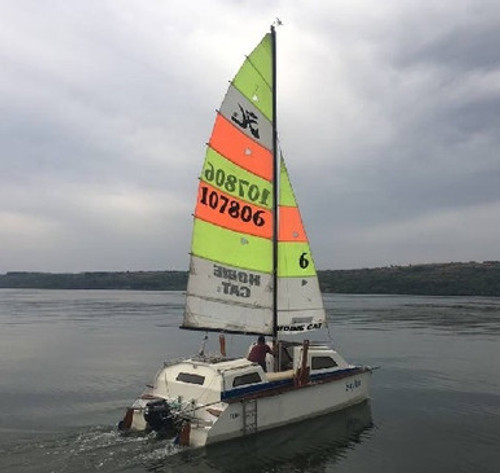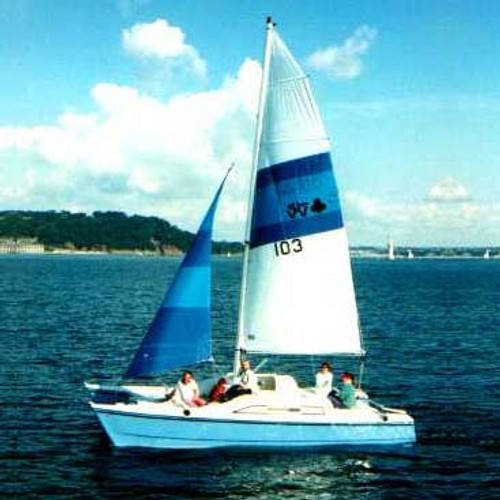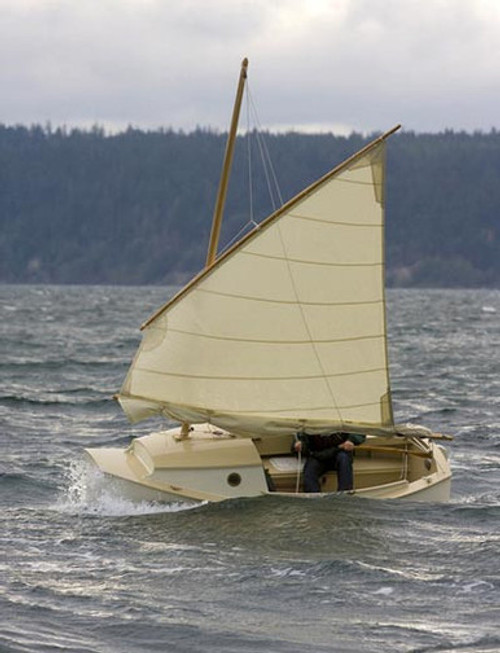Owner reports "Saylon is very nice and is a like a rockstar to the Danube River, both sides (Romania and Serbia). Very comfortable"
Scroll down to see a great sequence of build photos for the boat above
I have resisted designing a small bridgedeck cabin catamaran until now because I was brought up sailing in the generally rough and windy English Channel and so have always designed boats that would suit those conditions. However as I travelled the world I began to realise that many areas have much more benign conditions than we do in the UK, particularly in the USA and Australia. Both places where people may live a long way from the sea and sailing on lakes is their only option.
Which is probably why the small trailable bridgedeck cabined catamarans are popular in those areas.
Saylon is my version of the concept. It will appeal to those who want to gently cruise for the weekend with a young family (or maybe with grandchildren!) in sheltered sailing waters. It is not intended as an offshore boat, nor for those who want to race. Please check out my other trailable designs if that is what you want to do.

It is a very small boat - some beachcats are longer - so at most it is really only suitable for two adults and two small children. Most small boats trim by the stern when the crew sit in the cockpit. Furthermore, with a single forward cabin the parents get no privacy.
So the major difference between Saylon and other similar boats is that there is a centre cockpit and an aft double cabin. That helps keep the weight out of the ends, it also makes sail handling easy and separates the living and sleeping areas.
I call Saylon a "motorsailer" because it will not be as fast a boat as my Acorn or Janus designs, for example. The hulls are simply too fat and too close together. The rig is small because the narrow beam means that stability is limited. That's also the main reason why I call it a "Sheltered Water" only boat (Category D under Europe's RCD).

The rig can come from a beach cat eg Hobie 16. The mast is stepped on the cockpit floor so that it is easy to raise. It would be a real struggle stepping the mast from the cabin top. Hoisting the mainsail and reefing can be done safely from the front of the cockpit. With a furling jib there is no need to go on the foredeck when underway.
The sails are small enough that no winches are required, the jib has a 2:1 purchase. The mainsail has a good downhaul and a "gnav" (an upside down kicking strap as seen on many racing dinghies) to control sail twist, yet not intrude into the cockpit. So the sails can still be set efficiently.
The steering is "monohull friendly" with a central tiller and cockpit seats as on a monohull. However extending "wings" can be used for more crew righting moment for keener crews.
Photo shows a Saylon being built in Romania. Great building frame! Then a few days later

Photo from February 2017, build started at Christmas 2016
Planking dry fitted March 2017. Note slots for daggerboard cases and cutout for "Pop bottom"
and then this from the end of March
and then just a few days later
and not long after that (Apr 19th)
and just a week later!
4mm plywood 3 sheets or 13 sheets (depending on hull planking thickness)
9mm plywood 3 sheets
Timber
11/2in x 1in (finished size 35 x 20mm approx) 150m
2in x 1in (finished size 45 x20mm approx) 35m
1in x 1in (finished size 20 x 20mm approx) 50m
3in x 1in (finished size 70 x 20mm approx) 10m
4in x 11/2in (finished size 95 x 35mm approx) 3m
Epoxy approx 40kgs plus fillers as reqd
400g biaxial glass 5kgs
200g glass cloth for sheathing 8kgs (can be 300g, 12kgs)
paint, filler etc as reqd
All plywood to be best quality marine grade Gaboon/okoume ply.
Sheet sizes are 8' x 4' (2440 x 1220)
All timber to be "Joinery Quality" or better softwood. Use Douglas Fir, Yellow Cedar, Sitka Spruce or similar. Sizes given are nominal "PAR" (Planed all Round) ie 2" x 1" has a "real" size of approx 45mm x 20mm
At 20 feet, it is a very small catamaran - some beachcats are longer - and is designed to appeal to those who want to gently cruise for the weekend with a young family (or maybe with grandchildren!) in sheltered sailing waters. It is not intended as an offshore boat, nor for those who want to race. Saylon may seem a small boat, but it's huge compared to a 20ft monohull. In part that's because it is basically a rectangular shape. But also because the whole deck is usable space, while on a monohull you're generally restricted to the windward side.
The whole deck area is maximized, with the bridgedeck taken as far aft as possible, just leaving room for the rudders and outboard. Transom steps are built into each hull. There are watertight compartments for safety in case of collision or damage when grounding, but there is still plenty of storage space both above and below deck.
The center cockpit of the Saylon is a major feature which offers two advantages. First, it affords privacy by separating the double aft sleeping cabin and the forward cabin with galley and two single bunks. Second, the center cockpit keeps the crew's weight out of the ends and also makes sail handling easy.
Another feature that makes Saylon easy to handle is the simple rigging. The mast is stepped on the cockpit floor so that it is easy to raise. Hoisting the mainsail and reefing can be done safely from the front of the cockpit. The furling jib means there is no need to go on the foredeck when underway. The rig is small to assure stability because of the narrow 8 foot beam and no winches are required. The steering is "monohull friendly" with a central tiller and cockpit seats as on a monohull.
"Pop tops" are common on camper-vans and small boats alike, and one is used on the Saylon. A variation of that idea, also used on Saylon, is the "pop-bottom". The forward part of the bridgedeck is lowered when at rest, giving extra sitting space and standing headroom, and is raised when underway. A waterproof "bag" surrounding the pop-bottom keeps you dry. That gives Saylon nearly 10sqft of standing area in the saloon.
Trailability is another important feature. Saylon is small and light enough to be towed behind a small family car on a simple flat bed trailer. The shallow flat-bottomed hulls make loading simply a matter of floating the boat onto the trailer and securing it. Much easier than a deep keel or even a centreboarded boat. And, with no assembly required - apart from raising the mast - you'll spend no longer at the slipway than you would launching a monohull.
The hull shape is based on a combination of my very successful Strike trimarans and Skoota powercats. It is basically a flat bottomed dory hull but V'eed near the bow to reduce slamming. The topside chine increases space below without changing the beam, which obviously is limited by the trailerability requirements. The side decks allow easy boarding and walking forward when coming alongside.
Finally, construction is fast and inexpensive. It is a flat panel ply/epoxy boat that is very easy to build single-handed in a regular garage. Allow 500 building hours ready to paint.
During the last fifty years I have designed and enjoyed sailing fast boats that handled well in rough seas and windy weather. And I still do, but as I've grown older I've also come to realize there is much to be said for a leisurely, comfortable afternoon sail with friends and family. Or an overnight trip to a secluded bay to enjoy the sunset, picnic ashore and then settle in for a night on the water. I believe Saylon is the boat that will deliver just that.
LOA 6.1m 20ft LWL 5.9m 19ft4in
BOA 2.5m 8ft2in
Sail Area Mainsail 13sqm 140sqft Jib 7sqm 75sqft
Mast height 8.8m 28ft9in
Empty weight 680kgs 1500lbs
Displacement to WL 920kgs 2030lbs
Draft 285 11in (1000 3ft3in boards down)
2 single berths in hulls 1 double in aft cabin
Headroom 1.85m (6ft) moored 1.35m (4ft6in) sailing



















